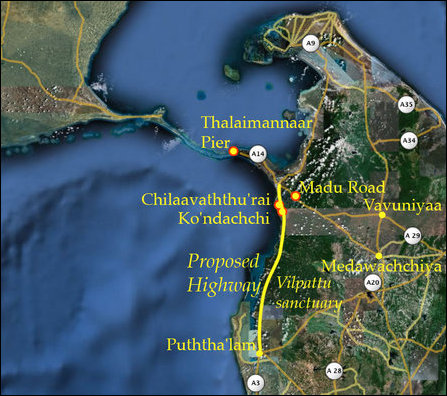Three-pronged Sinhala Colonization in Mannaar
by TamilNet, February 15, 2010
|
In the meantime, a large Sinhala-Buddhist settlement is carefully planned centring around Madu Road Junction railway station on the Medawachchiya-Mannaar line, where a Buddhist temple had already been built. |
 |
| Sinhala colonization in Mannaar District [Image courtesy: Google Maps, Legend by TamilNet] |
Chilaavath-thu’rai, as the name indicates, was the centre for pearl fisheries in the past, conducted by Tamils throughout history. Ko’ndachchi is a nearby tract where Colombo earlier planned cashew nut plantations and brought Sinhalese to settle there. These Sinhalese went back south during the war.
While Tamils are yet to be resettled in their own homeland, new Sinhala migrants are now brought to settle Ko’ndachchi and the coast of Chilaavaththu’rai. Everyday they come with cadjans and other housing material through the track in Vilpattu National Park, news sources said.
This road, which was a traditional route of communication for Tamils, was closed in British times. Sinhala colonizers are now allowed to use this road of 102 km in the daytime until 3:00 p.m. They also come from Medawachchiya.
Developing the Vilpattu route is already under discussion between New Delhi and Colombo. By the time the highway is developed one could see Sinhala colonies well established all along it, Tamil circles in Mannaar said to our reporter.
They also pointed out that the Indian government agreeing to develop the Medawachchiya-Mannaar railway track would only help Sinhala colonisation of the district. Instead, India should have prevailed upon Colombo to build a track from Vavuniyaa, if protecting Tamils is anywhere in its agenda, they said.
Some of the Sinhala settlers to Chilaavaththu’rai come with their boats. This has already created tension in the Tamil fishing villages of Chilaavaththu’rai and nearby Vangkaalai. Normally, new fishermen have to get permission from three government agencies (Fisheries Ministry, Pradesha or Town Councils and the Divisional Secretariat). But in these cases of State-sponsored colonisation everything is going to be either overlooked or fabricated, fishermen of Mannaar said.
The presence of Sinhalese in the Mannaar district earlier was around 1.4 percent, according to 1981 census data.
In the meantime, a large Sinhala-Buddhist settlement is carefully planned centring around Madu Road Junction railway station on the Medawachchiya-Mannaar line, where a Buddhist temple had already been built. Madu is the famous pilgrim centre of Tamil Catholics, where even the Sinhalese Catholics of the western coast, who were Tamils a century ago, flock in for festivals.
News reports have already flashed the activities of a Buddhist monk who is said to have purchased 100 acres of palmyra grove land from the poor Muslims of Thalai Mannaar Pier, to develop a Sinhala-Buddhist settlement. Local people say the monk has a license to use a rifle. The monk, believed to be a supporter of the JVP, is looking for sponsors from the South.
A question often raised in Sinhala-Buddhist circles is what is wrong in the colonies and in building Buddhist temples when there are a large number of Hindu temples in the South.
“Tamils by their heritage can never be opposed to Buddhism or any other faith, for unlike Sinhala, their language served as medium to all the religions. What is obviously rejected is genocidal Buddhism.* The Sinhala-Buddhists have to ask their question after conceding sovereignty to Tamils in their homeland, just like they enjoy sovereignty in their land. If this can be sorted out, not only Buddhist temples and the presence of Sinhalese may peacefully co-exist in the north and east, but even a section of Tamils may come forward to patronize Buddhism,” Tamil circles commented.
Eezham Tamil circles questioned the very theological sanity of Sri Lankan Buddhism, citing the recent stand taken by all the prelates of the Buddhist Maha Sangha, and citing their ineradicable attitude towards Tamils. Eezham Tamils have achieved comparatively a more progressive society in which no Hindu priesthood can meddle with politics, Tamil circles said, comparing that with the predicament of the Sinhalese at the hands of the monks.
“They blame Tamils for casteism. But all backwardness of caste and feudalism is the rule of those monasteries. Coupled with military victory and electoral endorsement of genocide, what comes from them to Tamils is a monstrous religious culture,” Tamil circles further said.
Related Articles:
14.02.10 Theological premises of Maha Sangha raise questions
02.02.10 India plays upon Buddhist emissary while monks colonize Tami..
01.12.09 Grabbing land for wrecking contiguity of Tamil homeland
30.06.09 Ploy of Buddhism in nullifying Tamil nationalism
19.06.09 Sinhalicisation insinuated in Musali
04.04.08 The temporal and spiritual conquest of Tamils: Mahinda's boo..
*genocidal Buddhism - a state-sponsored Buddhism that is bent on subordinating or eradicating other religions and cultures, often without regard to the sanctity of life.
|
 Home
Home Archives
Archives